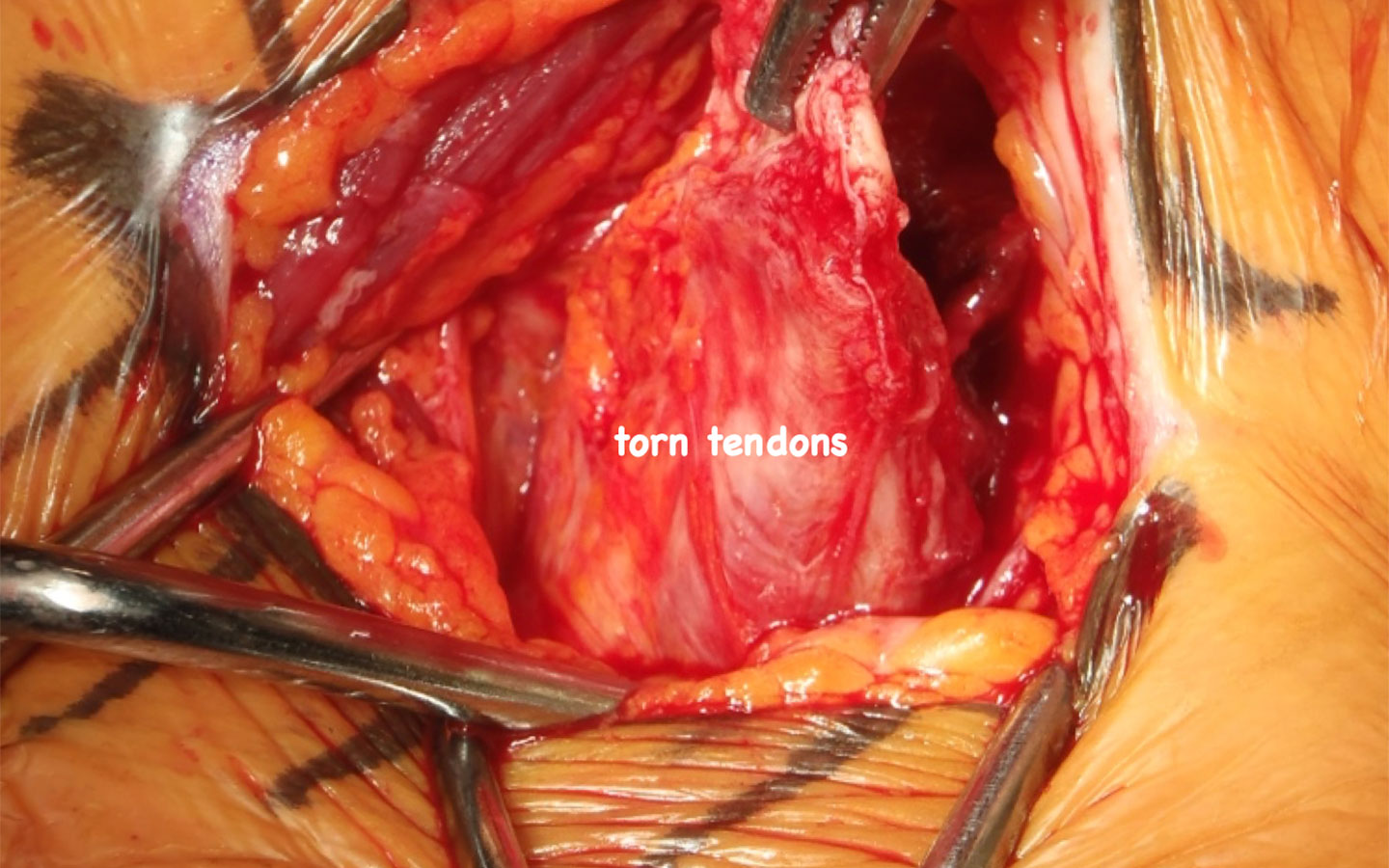The hamstrings are comprised of three separate muscles (semitendinosus, semimembranosus, and biceps femoris) that run along the back of the hip and knee joints. Collectively they function to extend the hip and flex the knee during activities such as running and jumping. They originate on a part of the pelvis called the ischial tuberosity, a prominence that can be felt as the bony part of the buttock when you sit down on a hard surface.

Hamstring injuries or tears are diagnosed by combining a patient’s story, clinical symptoms (pain, weakness, deformity) with MRI findings indicative of tendon degeneration, partial thickness tearing, or complete tearing.
The most common hamstring injury is a muscle strain due to excessive exertion or forceful contraction without proper conditioning (sprinting, hurdling, water skiing). In severe cases, partial or complete muscle tears can occur resulting in severe weakness and bruising. In general, hamstring strains take 4 – 6 weeks for full recovery while partial or complete muscle tears may take 3 – 6 months. Almost all muscle strains and tears can be treated without surgery using rest, ice, physical therapy, and platelet-rich-plasma (PRP) injections when indicated. Proper stretching and conditioning is the best method of preventing future injuries.
Hamstring tendon injuries are different from muscle belly injuries, and are divided into two types: acute and chronic.
Hamstring tendon repair is a procedure designed to treat painful tendinosis and tearing of the hamstring tendons. The outpatient procedure is performed under general anesthesia and typically takes 1 – 2 hours. A small (2 – 3 inch), cosmetic incision is made in the buttock crease and the area of tearing/tendinosis is identified and debrided. Bone suture anchors are utilized and the sutures are placed through the tendons to repair them back to the bone. Given that the hamstring tendons span both the hip and the knee, a post-operative knee brace is applied to keep the knee flexed and take tension off of the repair.
The speed of recovery depends largely on the extent and type of tearing/tendinosis along with other patient related factors. Partial thickness tears that have not completely separated from the bone or complete tears that are identified early (acute) tend to recover fastest. Chronic tears (present for > 6 months) or ones that have completely separated from the bone (retracted) tend to form scar tissue and adhesions, which complicate surgical repair and prolong recovery. Generally speaking, though, the majority of patients can expect to:
Physical therapy is critical to ensure that you get the best outcome from your surgery. With the guidance of your therapist, you will progressively advance through the various stages of your rehabilitation, as outlined in our post-operative protocol. Your therapist will have some flexibility to safely modify your progression in order to meet your specific goals and expectations.
Given that the hamstring tendons span both the hip and the knee, a post-operative knee brace is applied to keep the knee flexed and take tension off of the repair. The brace will initially be locked at a high degree of flexion (40°– 60° depending on the extent of retraction/scarring) and will gradually be extended over time. Patients with acute/partial thickness tears with good tendon quality and a robust repair may be allowed to discontinue the brace after as little as 2 – 3 weeks. Those with chronic/retracted tears having poor tendon quality and a tenuous repair often have to wear the brace for a full 6 weeks, and sometimes longer depending on the degree of scarring and retraction. We will teach you how to maintain passive knee motion during the time you will be in a brace to prevent knee stiffness.
The vast majority of scientific studies have produced good to excellent outcomes in 80 – 95% of appropriately selected patients undergoing hamstring tendon repair. The reproducibility of these results is dependent on many patient and injury related factors. Dr. Mei-Dan will help you understand your unique condition and what you stand to gain with surgery, so that you can define realistic goals and expectations.
Whether hamstring tendon repair is a worthwhile option depends on a number of factors, including:
In general, the outcomes of hamstring tendon repair are best for acute tears or partial thickness tears with good tissue quality. Dr. Mei-Dan will guide you through the various considerations in helping you decide whether surgery is right for you.
Choosing the treatment option that is right for you involves careful consideration of your diagnosis, duration and severity of symptoms, desired level of activity, as well as social and financial elements. You are not alone in this process.
As you research your condition, please write down all of your questions and bring them with you to your next appointment. The team will take time to address all of your concerns, until you are completely satisfied with your treatment plan.